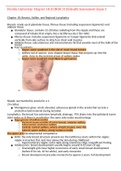Tentamen (uitwerkingen)
Florida University: Chapter 18-25|NUR 3125 Health Assessment Exam 3,100% CORRECT
- Vak
- Instelling
Florida University: Chapter 18-25|NUR 3125Health Assessment Exam 3 Chapter 18: Breasts, Axillae, and Regional Lymphatics Breasts: made up of glandular tissue, fibrous tissue (including suspensory ligaments) and adipose tissue ● Glandular tissue: contains 15-20 lobes radiating from the nipp...
[Meer zien]




